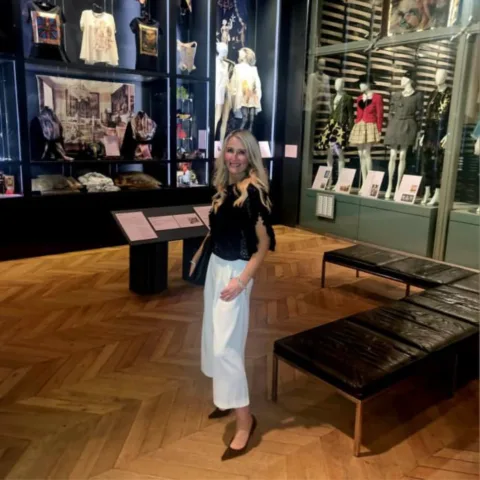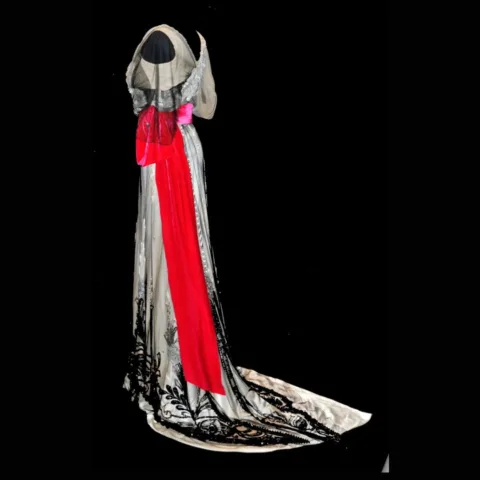The Bowes Museum Blog

A Coat of Many Colours: Conserving an 18th Century Technicolour Dream Coat

Treatment is now complete on this stunning late 18th century coat of brown cut and voided silk velvet, adorned with polychrome floral embroidery and appliquéd net (CST.1.292.A). The coat is part of a two-piece suit but, unlike the breeches (CST.1.292.B), which require very little conservation work, the jacket posed a number of issues prior to its display. The coat was shown in the 2013 exhibition Henry Poole & Co. as an example of 18th century bespoke male tailoring. Little is known about this garment’s provenance, but it is typically French in style. The numerous embroidery workshops located in Paris during the second half of the 18th century were famed for their luxury formalwear. Customers would travel to the city to select their elaborate pre-embroidered panels at astonishing expense (as much as six hundred francs per aune), which would then be cut, pieced and finished to fit the wearer.
The cream silk satin collar lining was abraded, and beginning to split in places from use. Patches of silk habotai were dyed to colour-match the silk fabric, and inserted underneath areas of damage. They were stitched in place using laid thread couching, with a colour-matched Gütermann Skala 360 polyester thread.

Left to Right: Splits in the silk collar lining; laid couching stitching in progress; after conservation
After due consideration outlined in a previous blog ‘Should It Stay or Should It Go: Historic Alterations to Costume in the Museum’ the decision was made to remove and replace an underarm patch in the coat’s lining. Removal of previous repairs is not common textile conservation practice, as they are often seen to contribute to an object’s biography. However, the patch was synthetic and was therefore likely to have been applied in the object’s recent past as a quick-restoration-fix, it was fairly unsightly, provided no support and prevented access for something more structurally appropriate, it had to go! Its removal revealed a rather creased, fraying hole in the lining fabric which was humidified with dampened blotting paper, separated from the object with Sympatex® (a semi-permeable membrane) and held in place with magnets.

Left: Removal of patch repair under arm. Right: Humidification of damaged lining
Heavyweight silk satin was dyed to colour match the lining, and used as a support fabric below the hole, couched once again, with Gütermann Skala 360 polyester thread. Finally, the underarm lining was overlaid with a patch of fine conservation grade nylon net, to prevent the fragile portion of the inner coat catching on a stray arm during costume mounting.

Lining at underarm, with patch support, and net overlay
Next it was time to tackle the delicate appliquéd net on the exterior of the coat. Nylon net was dyed to colour-match, and small patches cut to size, and stitched over damaged areas. This was to prevent holes in the original appliquéd net from worsening, and provide a little aesthetic infill for the areas of loss.

Left to Right: Before conservation; with net pinned in place; after conservation

Stitching the nylon net in place, wearing Optivisors to help see clearly
The final stage of conservation treatment was to support two splitting brown twill silk patches under each arm on the exterior of the coat; a slight anomaly in the overall design suggesting that these had been inserted at some point in the garment’s history in an attempt to widen the arm holes. The decision was made to leave the patches in situ; there was no indication when this chunky-armed wearer had taken custody of the coat and potential eradication of evidence of wear meant that patch removal could not be justified. Furthermore, their removal would have left yet another hole, potentially causing further damage. The ethical and practical conservation choice was made to support the splitting brown patches with additional patches of dyed brown silk habotai inserted below, then couch-stitched over the top.

Left to Right: Before conservation; stitching in progress; after conservation
The conservation treatment to date has totalled eighty-eight hours, undeniably a lot of work for one garment and the object is still to be mounted on its custom-cut acrylic mannequin. Conservation has, however, ensured that the object is now robust enough for inclusion in the Fashion & Textile Gallery. It has been a real pleasure to work on such an exquisite piece and, while for this coat it may have been a long time in the treatment room, as far as internship projects go it feels like a pretty speedy learning curve.
Jamie Robinson, Textiles Conservation Intern
![]()







